Key findings
- 83% of weed species have remained stable or increased since 1970.
- Proportionately more annual weeds have decreased and more perennials have increased.
- The proportion of undersown cereals has decreased.
- Perennial weed resistance to herbicides has increased.
- Annual weeds have become more susceptible to herbicides.
The Sussex Study is a large-scale, long-term study on the Sussex Downs to document changes in the biodiversity of the cereal ecosystem with special reference to the grey partridge. In 2005 we analysed changes in arable weed abundance and diversity that have taken place during 1970 to 2004. We compared these changes to changes in cropping and crop management.
We sample insects and weeds in cereal crops during the third week of June. Our timing is designed to coincide with the period when grey partridge chicks are hatching. Insects are the preferred food for grey partridge chicks immediately after hatching because they provide essential protein for growth and feather development. Some of the insects that chicks prefer feed on weeds in the crop. The Sussex weed sampling is designed to collect the maximum information about the presence of weeds in the minimum amount of time.
Weed occurrence is recorded in the cereal crops at the same location as insects are sampled, together with separate grass and broad-leaved weed abundance scores (0 to 5, where 0 reflects no weeds of that type present and 5 complete dominance of the crop by the weeds). All in all, there have been 171 species (or groups of species) of broad-leaved weeds and 16 species of grass weeds identified during the 35 years. In this article, we restrict our analysis to broad-leaved weeds as these provide a majority of the food both for chick-food insects and for the partridges themselves.
For each species, we calculated a value for relative change through the 35 years by fitting a curve to its percentage occurrence across the study area, using the difference between the values calculated at 2004 minus the values in 1970, dividing by the values in 1970. We grouped the species into annuals and perennials (ignoring biennials for the present purposes) and calculated the average relative change in occurrence across the species in each group.
Overall, out of 60 species common enough to measure trend, 50 (83%) were stable or increasing (see Table 1 and Figure 1). Proportionately more declines and fewer increases were seen in the occurrence of annual weeds than in perennials.
Table 1: Status of weed species in cereal crops in the Sussex Study: 121 species where trends could be discerned
| Category of status |
Annuals (85 species) |
Perennials (36 species) |
| Gone prior to study |
8 |
0 |
| Uncommon |
40 |
13 |
| Significant decline |
8 |
2 |
| No change |
8 |
3 |
| Significant increase |
21 |
18 |
| Percentage increasing |
24.7 ± 4.7% |
50.0 ± 8.3% |
Figure 1: Decrease and increase of broad-leaved weed species in the Sussex Study
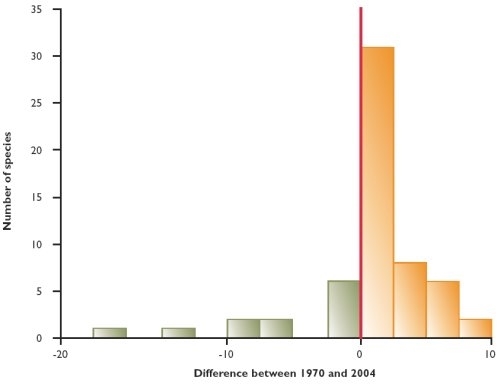
More broad-leaved species (total 60) have increased than have decreased over the 35 years of monitoring weeds in Sussex.
Unfortunately for the grey partridge, the weeds that they most prefer are the ones that have declined like chickweed, redshank and pale persicaria. We compared the changes in the overall number of annual (see Figure 2) and perennial (see Figure 3) weeds identified in cereal fields over this period with cropping and herbicide efficacy.
Average yearly occurrences were compared with the proportion of the fields monitored that were undersown - a measure of how much traditional ley farming there was in a given year (see Figure 4 overleaf), the introduction of set-aside (measured as the number of fields monitored for weeds that were in set-aside the previous year), the ratio of spring-sown to winter-sown cereals, and the proportion of annual and perennial weeds that were susceptible or resistant to the herbicide cocktails applied on an average cereal field in each year (see Figures 5 and 6).
Average annual occurrence decreased as the proportion of spring- to winter-sown cereals increased and the proportion of annuals classified as susceptible to the herbicide cocktail used in Sussex increased. Average perennial occurrences increased as the proportion of set-aside increased and the proportion of undersown cereals decreased.
Figure 2: Trend in average overall number of annual weeds in cereal fields in Sussex, 1970-2004
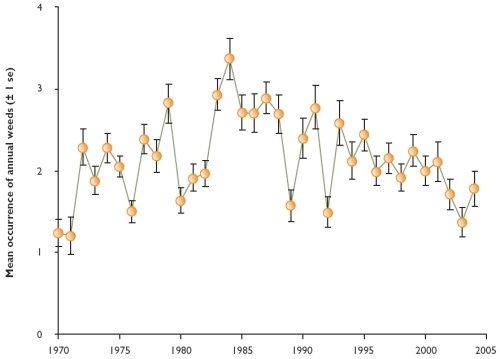
Figure 3: Trend in average overall number of perennial weeds in cereal fields in Sussex, 1970-2004
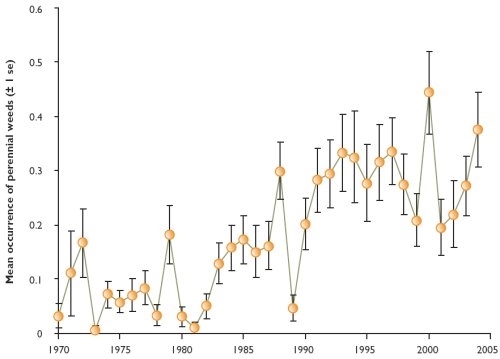
Figure 4: The proportion of cereals that were undersown in Sussex, 1970-2004
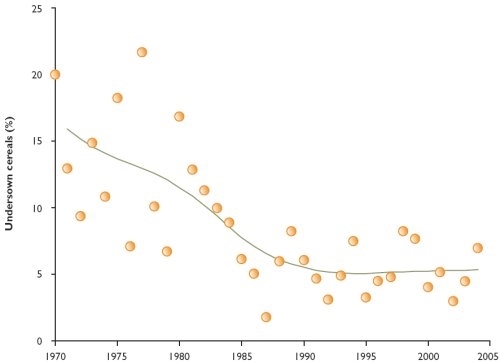
It appears that changes in the cropping regime and the changes in herbicides used over the period of the study have both had an effect on the weed flora in cereal fields in Sussex. Not all of this is detrimental. Some of the increasing perennials are substantial plants with considerable importance to wildlife, eg. hogweed, mugwort, burdock, and sowthistle.
Against this must be weighed the fact that many of the declining annuals are important to farmland birds, especially grey partridge, so it would be a positive step in the conservation of farmland birds if these declines were reversed or alternative food provided. The use of conservation headlands (with their defined herbicide regime, preferably with little nitrogen applied) should allow these annuals, including rare arable weeds, to hold on. The benefits of traditional ley farming for chick food insects are well established.
One of the advantages of a ley rotation is the control of pernicious weeds through rotations with cereals and undersown grass fields. The work reported here indicates that the move from a rotational ley farming regime, together with an increase in set-aside, resulted in an increase in perennial weeds. This has not, however, increased the overall annual weed occurrence, with an indication that this is due to the herbicide cocktail applied to cereal fields in Sussex.
Further analysis is underway to examine the relationship of both the farming regime and the herbicide cocktail on individual weed species occurrence. The Sussex Study is uniquely placed to examine these relationships and this is due to the patience and co-operation of the farmers within the study area, to whom we would like to extend our thanks.
Figure 5: The trend in the proportion of annuals classified as susceptible and resistant to the herbicide "cocktail" used in cereal fields in Sussex from 1970 to 2004
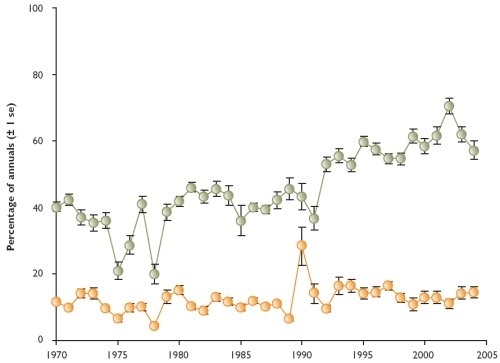
Figure 6: The trend in the population of perennials/biennials classified as susceptible and resistant to the herbicide "cocktail" used in cereal fields in Sussex from 1970 to 2004
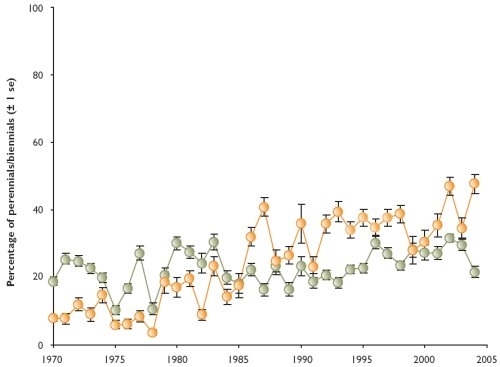
Figures 5 and 6 show how the proportion of annual weeds classified as susceptible
and the proportion of perennials classified as resistant have increased over time.